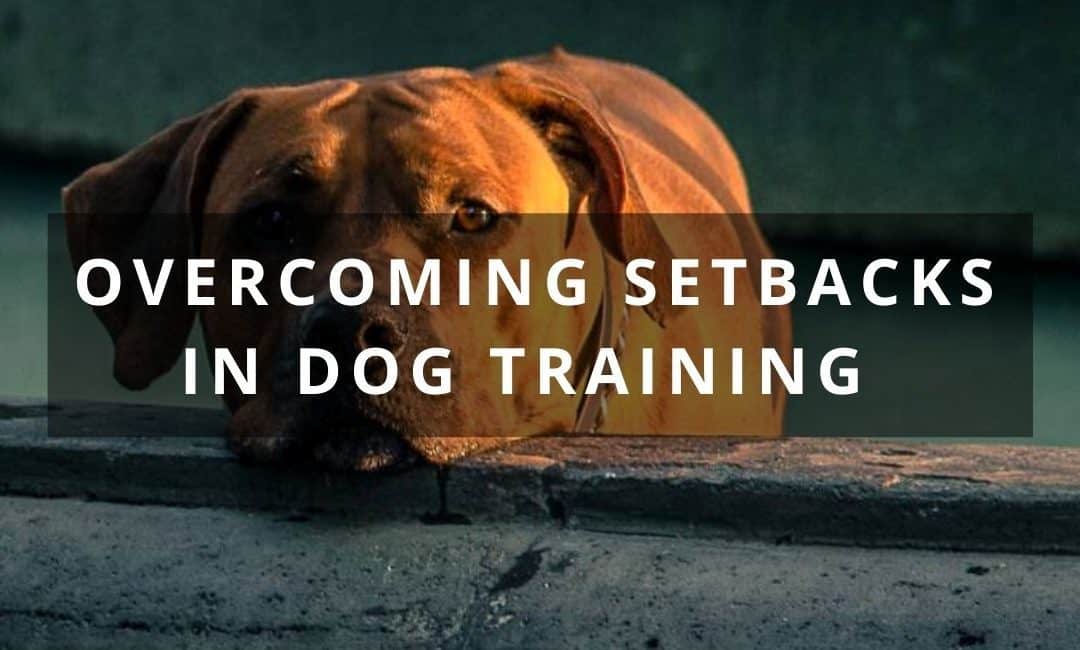Dog training setbacks are disappointing, frustrating, even infuriating. They are also virtually inevitable. Depressed yet? Don’t be.
Setbacks in dog training don’t need to signal failure. Because it’s not the bad experience itself, but how we respond to it, that can determine whether a setback is a minor pothole or an impassable boulder along our dog’s road to success.
You understand the concept of setting your dog up for success. “Make it easy to do the right thing, and hard to do the wrong thing.†We start out new dogs this way, and we fix behavior problems this way.
But sometimes, despite all our efforts, life happens – your dog has a bad experience anyway. Everything had been going so well! She’d made so much progress! What now?? Do we plow through; get her “back in the saddleâ€? Pretend it didn’t happen? Get discouraged and give up? Go on a bender? Get another dog? 😉
First off, take a breath. Pause and realize:
It’s not the end of the world. The sky has not fallen. Tomorrow is, indeed, another day.
Furthermore, you’re in good company. Setbacks in dog training have happened to the best of us, enough to come up with some “best practices†on dealing with setbacks.
So, when your dog experiences a setback you’re concerned will derail his progress, take heart. There are things you can and should do that can help minimize the damage. And things you can avoid so as to not make it worse.

After a Setback in Dog Training, Do Some or All of These
Give your dog a break
Change your routine for awhile. Take a behavioral vacation and give your dog a chance to forget the occurrence.
The break can last few days, weeks, or even months, depending on how serious the negative experience was. And “how serious†will depend not only on the quality and intensity of the experience itself, but on your dog’s resilience, length of time practicing the improved behavior without fail, etc.
The idea is to make sure that one bad experience doesn’t turn into a long-term setback.Â
A break also gives you a chance to cool off and avoid anxiously watching the dog’s every move to “see if he’s going to reactâ€. (In my experience there is no faster way to get a dog to be anxious and over-react than for their human to suddenly turn into a hyper-vigilant Nervous Nellie.
Been there, done that, and yes, I regret it!
Taking a break can be tough after a dog training setback, because we often feel that we have to “do somethingâ€. (This is especially true of the professional and hobby trainers among us.) In this case, however, it may well be that the best something to do is to leave it alone.
​Buffer your dog from mistakes and negative behavior
Visit less-challenging places to walk or train. Keep exposures in challenging places or situations brief, leaving before you see a sign of negative reaction. If needed, lower your requirements for reinforcing your dog. (This is known as “going back to kindergarten” in dog training circles.)
​Change the context
Do something different, somewhere different. Changing context after a dog training setback makes it easier for your dog to give fresh, untarnished responses.
Try working in some new locations. Try teaching something completely new and different to your dog. Make sure your dog has at least one alternative area of learning he can switch off to.
Besides being handy when there’s a setback, this will help your dog maintain valuable mental and emotional flexibility.
​Practice confidence-building routines and exercises with your dog
What types of things build confidence in dogs? Lots!
Having a safe, predictable routine builds confidence. Learning new behaviors (whether silly tricks or useful life skills) is confidence-building.
Letting your dog explore, sniff, climb, jump, splash… all not only instill confidence but are great ways to re-set and refresh your dog physically and emotionally.
​Actively appreciate any and all efforts at improvement
Take time to notice and praise your dog when his behavior is agreeable to you. You can praise for concrete actions like sitting, staying or coming when called, or for things like “being brave” or “being polite”.
Your praise doesn’t need to be over-the-top, just sincere and in-the-moment. Read 3 Simple Exercises to Improve Cooperation and Willingness for practical tips on active appreciation and more.
Review your attitude, body language and demeanor, and your comfort level in your dog’s problem situation
If you have trouble communicating clearly and effectively with your dog, try to work on this as a separate skill.
Clear, clean communication can have a surprising impact on recovering from setbacks in dog training.
​Check your leadership skills
Are you are reliable, trustworthy leader who inspires confidence and a sense of security in your dog? What is and isn’t good leadership (and even if it’s necessary) is an ongoing (some would say never-ending) topic of debate among dog trainers.
Read The Role of Leadership in Dog Training for my take on this topic.

After a Dog Training Setback, Don’t Do These
Don’t cement the bad reaction
Avoid – and I mean like the plague – the temptation to rush and “try her outâ€, i.e. to see if the bad reaction is “still thereâ€. Seriously, there is no surer way to cement a bad reaction than to repeatedly set it up to occur.
When you believe your dog’s ready to get back into the situation that triggered the setback, do so slowly, gradually, deliberately and thoughtfully. If there were multiple factors involved, re-introduce them to your dog one at a time to begin with, not all at once.
Don’t baby and spoil your dog in an attempt to “make up” for the setback
You may be sorely tempted to do this, but it will not pay off in any positive way. Instead, be patient, be kind, be understanding, be consistent, and be a good leader.
Don’t take your frustration or disappointment out on your dog
That is, don’t get impatient with him, or project your emotions about the setback onto him. This is harder for some of us than others!
For some good tips on dealing with setbacks in general (not related to dog training), read 8 Ways Successful People Overcome Setbacks and/or 10 Ways to Move Forward After Suffering a Big Setback. Â
Conclusion
Setbacks in dog training happen to the best of us; they are not a sign of failure. The fact is, you’ve already learned your dog can improve and have a more balanced outlook and response. You’ve done it; it’s a historical fact.
So, while it’s tempting to be down and depressed about lost ground, it’s crucial to realize that the time and effort spent getting her there was not time wasted.
By responding in a thoughtful, structured way, you can minimize the negative impact, and ultimately even strengthen your dog’s behavior.
I hope this article was useful to you. If it was, please share it with your friends!
Best,
julie
(bio)
